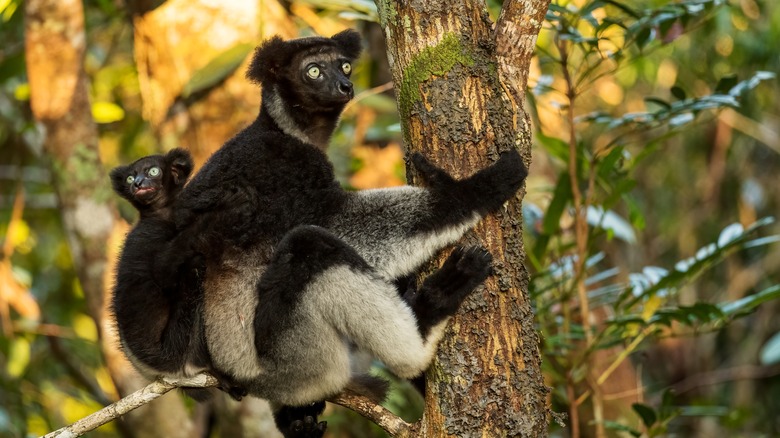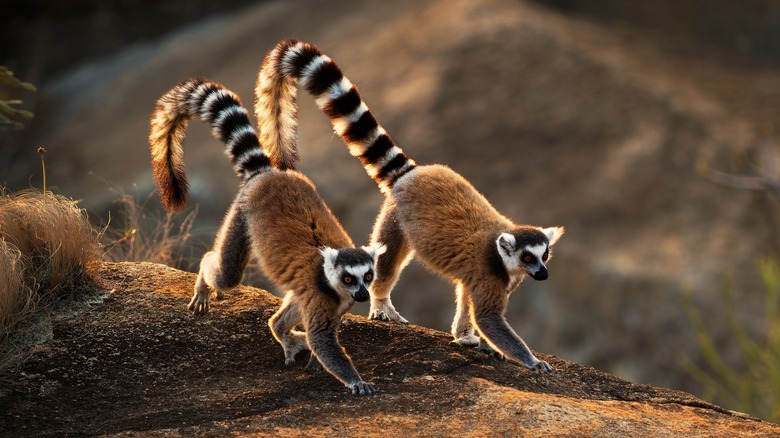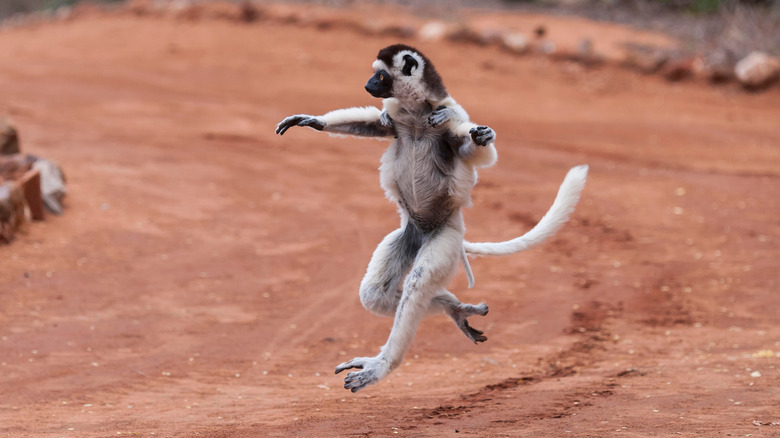You Can See Lemurs At Only One Spot In The World
Even without an adorable population of lemurs, Madagascar would be a stunning island nation worth visiting, but it helps to have 111 distinct species of primates looking like a cross between a teddy bear and a monkey. Their lineage began some 50 million years ago when early primate ancestors were thought to have crossed the channel between Africa and Madagascar. As the distance between the two land masses grew, the lemurs evolved in isolation, assuming the shapes, sizes, and colors we see today. All lemur species are endemic to Madagascar, meaning you won't naturally find them anywhere else on the planet.
About 4 hours east of the capital, Antananarivo, a visit to Andasibe-Mantadia National Park is one of the best things to do in Madagascar, and the park is home to the largest lemurs on record. Here, you'll find 20-pound, black-and-white indris sitting upright and marveling at visitors from the trees with their distinct bug-eyed gaze. Most peculiarly, they are the only animal species apart from humans who sing with a sense of rhythm. Their song is mildly reminiscent of a car alarm but efficient for communicating.
The park boasts 10 other species of lemurs, including diademed sifakas with coats that appear to have been dipped in gold. From Andasibe, it's worth heading northeast to Aye-Aye Island for a night tour. If you spot a pair of honey-colored eyes staring at you in the dark, it's the aye-aye lemur, a creepy yet loveable night-dweller with extra long fingers.
Ranomafana National Park and Anja Community Reserve
For an island, Madagascar is huge — the fourth largest in the world, in fact. Though it'll take a bit of effort in a car or on a tour to get around, it's well worth the view of lemurs in their native habitat. About 9 hours south of Antananarivo, Ranomafana National Park spans 102,000 acres with 26 species of lemurs, the most in one concentrated area. It's the perfect place to trek through the rainforest to spot the rare breeds of primates along with chameleons, lizards, butterflies, bats, carnivorous plants, and plenty of birds to boot. When you're done exploring, consider a dip in the park's natural thermal pool, which reaches a soothing 100 degrees Fahrenheit.
If you're up for more lemurs (who isn't?), head 3 hours south to Anja Community Reserve. You might recognize the ring-tailed lemurs right away, a well-known critter popularized by the 2005 hit film "Madagascar." The conspiracy (the collective noun for lemurs, if you were wondering) of 300 is well-accustomed to human beings, so don't be surprised if they come right up to you to say hello. There are two main hiking trails through the rocky terrain, loops of 2 hours and 6 hours, best enjoyed with a night of camping under the stars.
Berenty Reserve and tips for visiting Madagascar
On the southern tip of the island, about a 25-hour drive south of the capital, the Berenty Reserve is another fabulous place to spot wildlife. For decades, the 500-acre reserve has attracted scores of scientists and media crews alike for its population of ring-tailed lemurs and dancing sifakas, so named for their upright, sideways hop along the red soil that looks like a folk dance. They share their habitat with a large colony of fruit bats and 103 species of birds.
The best time to visit Madagascar is once the rainy season (November to April) ends. For a chance at spotting baby lemurs tucked into mom's fur, book your trip from September to October. Beyond lemur fever, there are plenty of incredible gems to explore, like the 100-foot baobab trees in the west, the dive spots with sharks and rays in the Gorgonian Forest, and the domain of humpback whales along the northern coast. No matter what calls to you on the "Great Red Island," it's sure to be a vacation you'll never forget.


